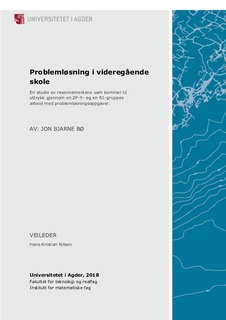| dc.description.abstract | The topic of this Master thesis is problem-solving in high school. To get an insight into how the problem-solving process can be described in high school I have, with socio-cultural glasses, assessed a problem-solving process in a 2P-Y group and a R1 group based on the research question:
What mathematical reasoning is expressed in a 2P-Y- and a R1-group’s work on problem solving tasks, and which phases characterize the process?
In my review of research literature, I came to realize that the research available on problem-solving was immense. Because of this, I had to restrict the theory presented so that it best answered the research question relative to the discovered findings. The research question is made up of two parts. Firstly, it involves to orderly present the different phases that characterize the problem-solving prosses, and secondly, it involves emphasizing the mathematical reasoning expressed in the process.
To answer the research question, I have chosen to categorize the problem-solving phase into 6 categories presented by Schoenfeld (1985). In addition, I will categorize the mathematical reasoning in three superior heuristics, presented by Mason and Davis (1991), respectively: Specialization, Generalization and Conviction. The mathematical reasoning that arose required me to divide specialization into another three heuristics: guess and check, make a table and look for a pattern.
The data material consists of video recordings, sound recordings and a collection of notes from two sequences that lasted 90 minutes each. The informants consist of a 2P-Y group of four students, and a R1 group of four students respectively. The data collection was conducted through observation of the groups while working on two given problems. The analysis is based mainly on video recordings and the students' notes from the process.
The two groups perform quite similarly during the problem-solving prosses. Both groups’ reasoning is largely characterized by guess and check, and there are also some examples of guesses. The groups also make use of tables, and the tables created lead in many cases to students seeing patterns and eventually arriving at explicit and recursive formulas.
Both groups seek to generalize, although the task asks for special cases, and although the students explicitly mention that they have the means solve the problem, it appears that they consider it more important to arrive at a generalization before answering the special case.
Although both groups made use of convincing, this convincing was largely characterized by convincing a friend. Thus, there is little reasoning containing complete proofs, and many examples of naive empiricism.
The majority of the problem-solving prosses the students find themselves in the exploration phase. The analysis phase that Schoenfeld (1992) argue is the most important phase when solving a problem, is the phase that get the least attention.
Finally, I will highlight how time-consuming such problem-solving tasks appear to be, and how self-regulation appears to a central part of becoming a better problem solver. | nb_NO |

